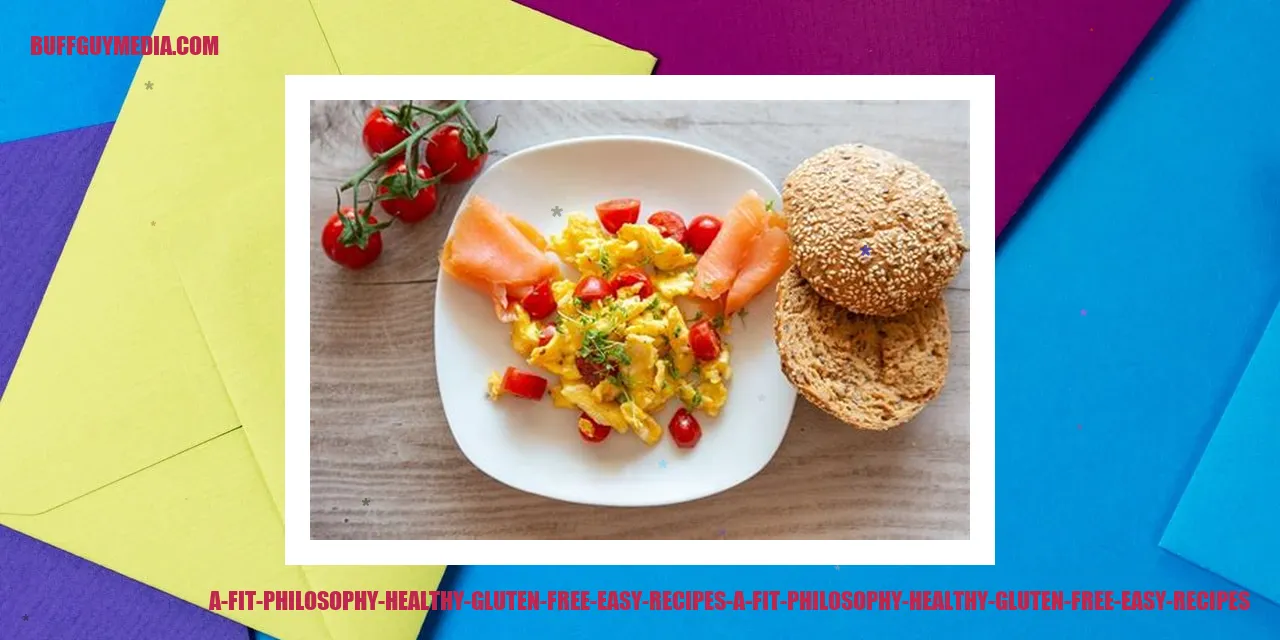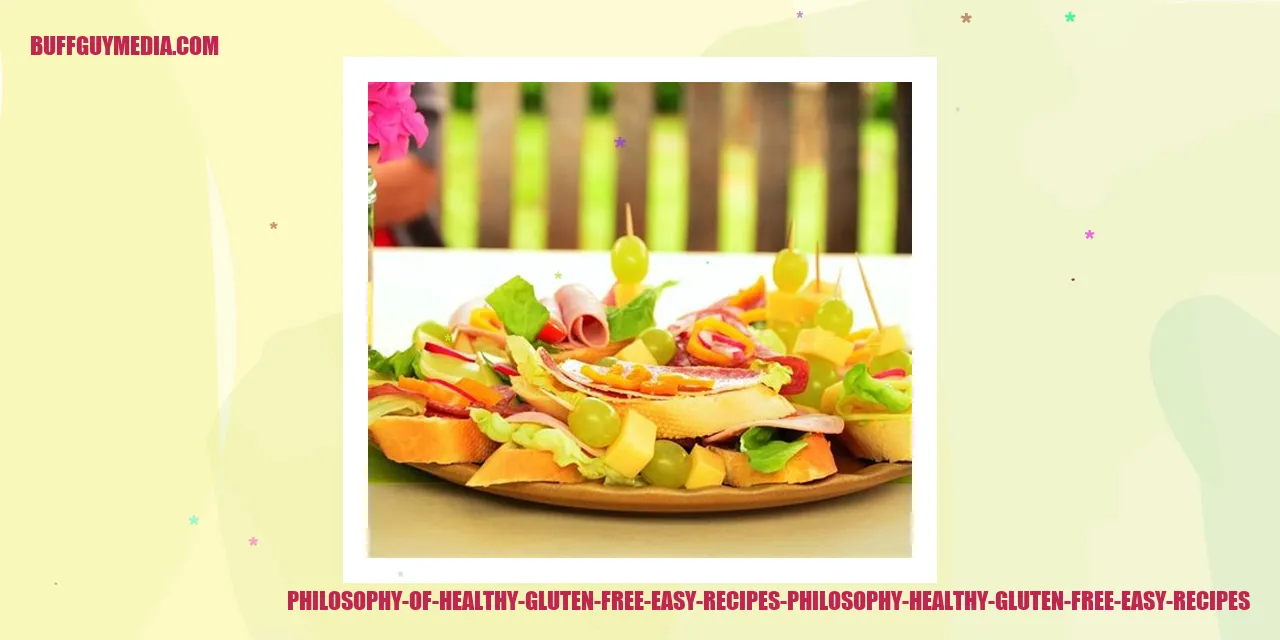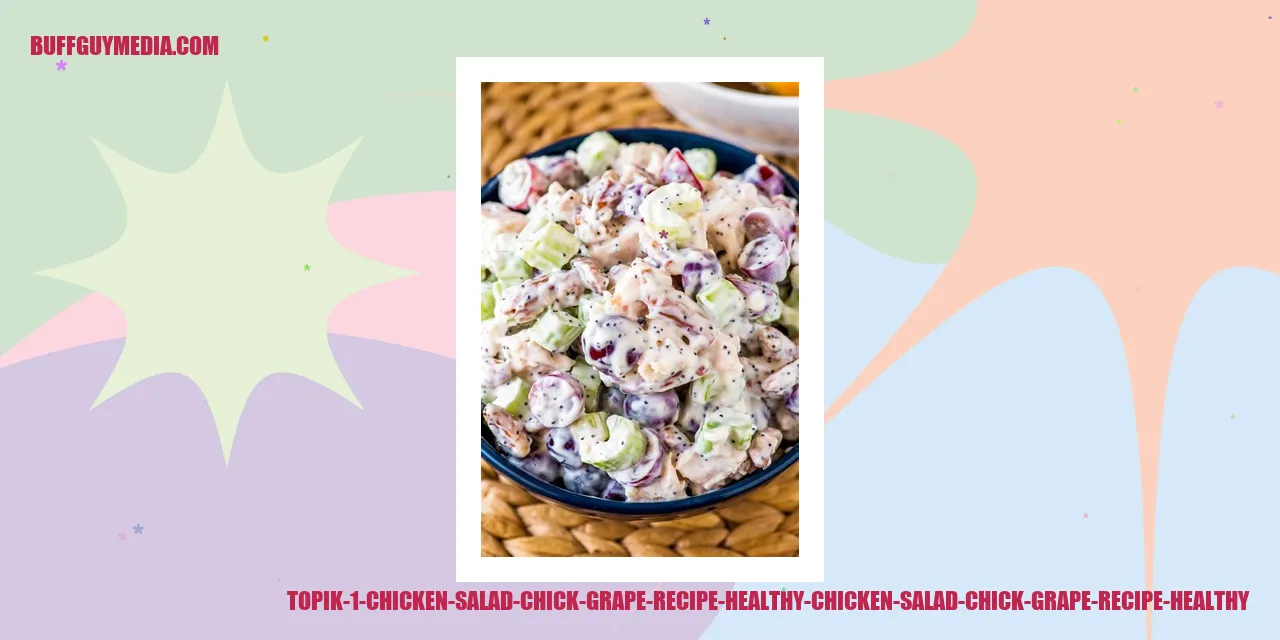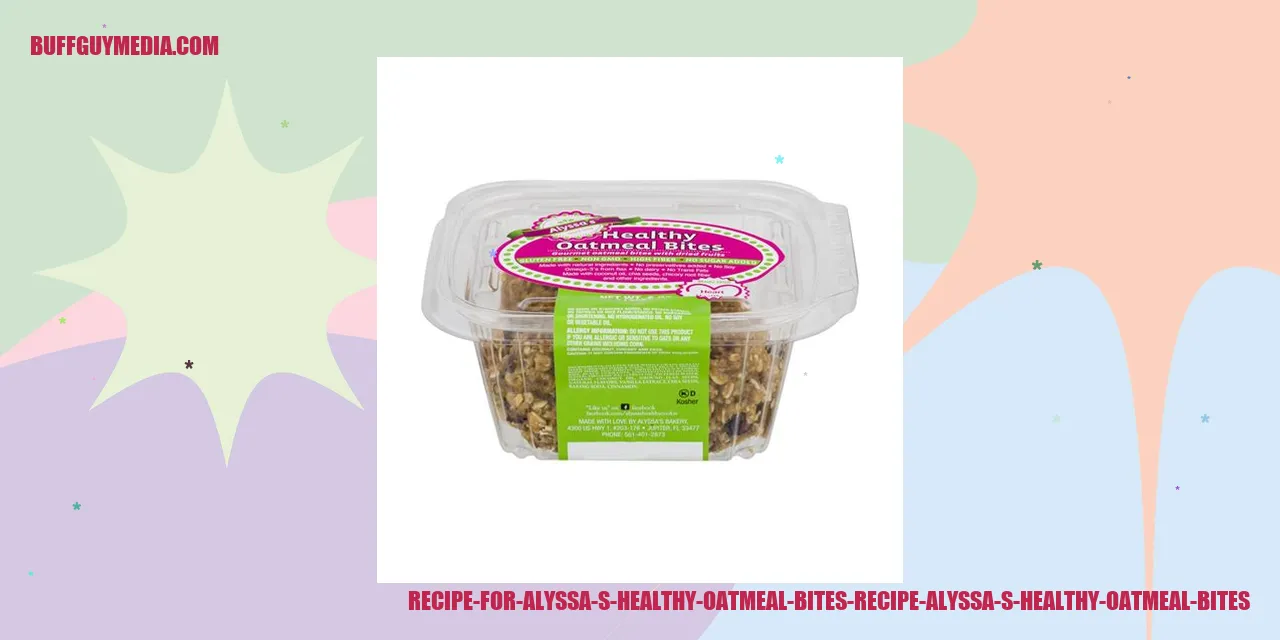A Fit Philosophy: Healthy Gluten Free Easy Recipes
Your Guide to Wholesome and Easy Gluten-Free Recipes
Start Your Day Right with Delicious Breakfast Ideas
Revitalize your mornings with a range of delectable and nutritious gluten-free breakfast recipes. Whether you crave a satisfying bowl of quinoa porridge or a fluffy vegetable frittata, our collection has something to offer. These recipes are not just simple to prepare, but they are also packed with wholesome ingredients that will fuel your body and kickstart your day.
Midday Meals Made Nutritious and Flavorful
Make your lunches both nourishing and enjoyable with our diverse array of gluten-free lunch recipes. From vibrant grain bowls to tasty lettuce wraps, our recipes will provide you with a satisfying and nutrient-packed midday meal. Say goodbye to boring lunches and embrace the delicious world of gluten-free eating.
Delicious Dinners that are Gluten-Free and Good for You
Elevate your dinner game with our inspiring selection of healthy and gluten-free dinner recipes. From zesty lemon garlic shrimp to hearty vegetable stir-fry, our dishes are bursting with flavors that will satisfy your taste buds and support your well-being. These recipes are quick to whip up and will keep you on track with your gluten-free lifestyle.
Satisfying Snacks to Tackle Between-Meal Cravings
Snacking doesn’t have to be a challenge when you’re following a gluten-free diet. Our collection of delectable snack recipes will keep your energy levels high and your taste buds delighted. From crispy kale chips to homemade granola bars, these gluten-free snacks are not only delicious but also packed with nutrients to keep you fueled throughout the day.

Essential Tips for a Healthy Lifestyle
The Significance of Regular Physical Activity
Incorporating regular exercise into your daily routine is vital for maintaining a healthy lifestyle. Engaging in physical activities not only helps in preventing various illnesses, but it also enhances your overall well-being. Physical exercise improves cardiovascular health, strengthens muscles and bones, and sharpens mental acuity. By making exercise a consistent part of your routine, you can boost energy levels, manage weight effectively, and uplift your mood.
The Advantages of Adequate Hydration
Maintaining proper hydration is essential for optimal health. Water is crucial for regulating body temperature, facilitating digestion, and transporting nutrients throughout the body. It aids in flushing out toxins and waste products, promoting healthy and radiant skin, and sustaining overall bodily functions. Ensuring sufficient hydration can also prevent dehydration, reduce the risk of headaches, and improve cognitive function.
[[READMORE]]
The Essence of a Balanced Diet
Attaining a well-balanced diet is crucial for maintaining good health. Consuming a diverse range of foods from different food groups ensures that your body receives all the necessary nutrients it requires. A balanced diet consists of a combination of fruits, vegetables, whole grains, lean proteins, and healthy fats. It provides essential vitamins, minerals, and antioxidants that support overall well-being, enhance the immune system, and decrease the risk of chronic diseases.
Effective Techniques for Stress Management
Also read:
Fasting Mimicking Diet Meal Plan PDF: Effective and Easy-to-Follow Guide
Mini Waffle Maker Recipes: Healthy and Delicious Options!
Managing stress is vital for both physical and mental well-being. Chronic stress can impact various aspects of your health negatively, including heart health, immune function, and mental clarity. To effectively manage stress, you can incorporate techniques such as meditation, deep breathing exercises, regular physical activity, and practicing mindfulness. Engaging in activities that bring you joy, connecting with loved ones, and maintaining a well-rounded lifestyle can also assist in reducing stress levels.

Gluten-Free Baking: Embarking on a Delightful Culinary Journey
Dive into the World of Gluten-Free Baking
Gluten-free baking has become increasingly popular in recent times, catering to individuals with gluten sensitivities or those following a gluten-free diet due to health concerns. Gluten, a protein present in wheat, barley, and rye, provides structure and elasticity to traditional baked goods. Exploring the basics of gluten-free baking allows individuals to take on the exciting challenge of creating scrumptious gluten-free treats.
Essential Ingredients for Successful Gluten-Free Baking
Gluten-free baking requires alternative ingredients to replace gluten’s binding and texture-enhancing properties. Key ingredients commonly used in gluten-free baking include almond flour, coconut flour, tapioca flour, and xanthan gum. By utilizing these ingredients, bakers can achieve the necessary structure and produce delightful baked goods that are as satisfying as their gluten-filled counterparts.
Tips to Master the Art of Gluten-Free Baking
Mastering the art of gluten-free baking can sometimes be challenging due to the absence of gluten. However, by following these essential tips and techniques, excellent results can be achieved. Accurate measurement of ingredients is crucial, as proper proportions are essential for success. Opting for a high-quality gluten-free flour blend significantly enhances the texture and flavor of your baked goods. Additionally, incorporating additional sources of moisture, such as applesauce or Greek yogurt, helps prevent dryness. Finally, patience and practice are key, as gluten-free baking often requires experimentation to achieve perfection.
Indulge in Irresistible Gluten-Free Baked Treats
Gluten-free baking offers a wide variety of mouthwatering recipes that can satisfy even the most discerning sweet tooth. From fluffy gluten-free chocolate chip cookies to moist banana bread, there are endless possibilities to explore. Enter the liberating world of gluten-free baking and delight in treats that are perfect for individuals with gluten sensitivities or those looking to expand their culinary horizons.
Unleash your creativity in the kitchen with these tempting gluten-free baking recipes that are sure to impress your loved ones:
- Decadent Gluten-Free Chocolate Cake with Raspberry Frosting
- Scrumptious Blueberry-Almond Muffins
- Delightful Flourless Peanut Butter Cookies
- Irresistible Gluten-Free Cinnamon Rolls
Embrace the world of gluten-free baking as a delightful and inclusive culinary adventure. With the right techniques, ingredients, and a touch of passion, anyone can create delectable gluten-free treats that will leave everyone craving for more.
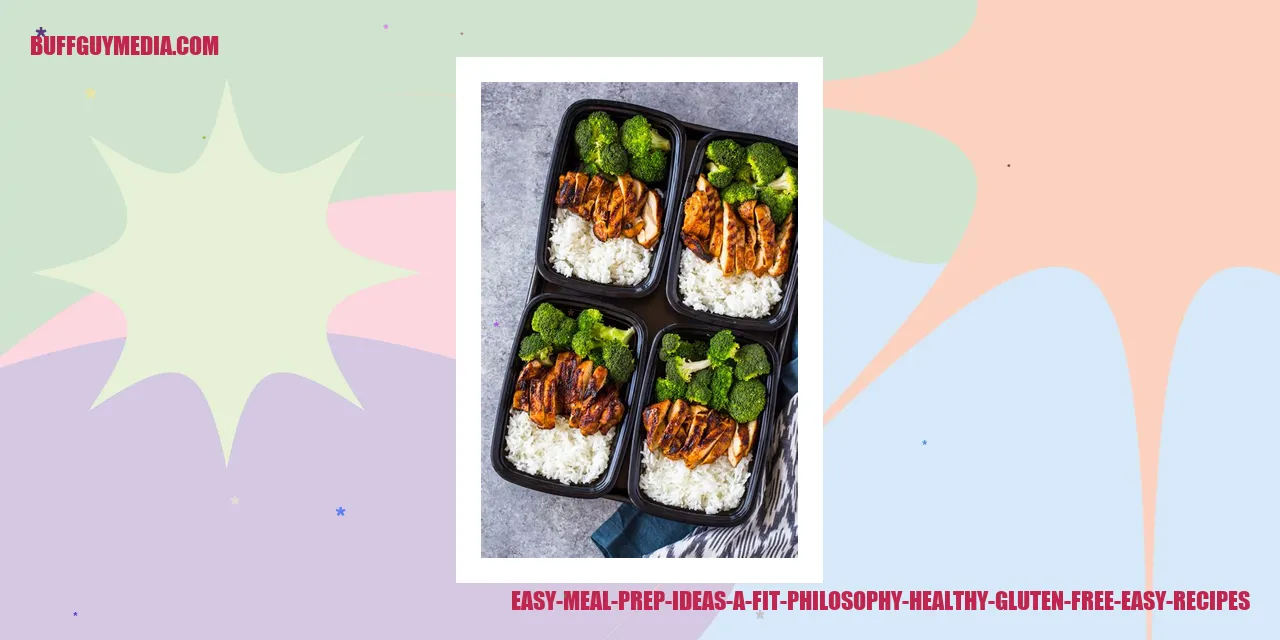
Fast and Convenient Meal Prep Ideas
The Advantages of Preparing Meals in Advance
Discover the numerous benefits of meal prepping, an indispensable strategy that saves you valuable time, money, and helps you adhere to your healthy eating objectives. By dedicating a few hours each week to pre-cook meals, you can rid yourself of the need to cook daily, minimize food waste, and have a variety of nutritious options readily accessible.
Must-Have Tools for Successful Meal Prep
Maximize your meal prepping experience with the essential tools and equipment that can significantly increase your efficiency. Invest in top-quality food storage containers to ensure your meals remain fresh and well-organized. Additionally, equipping yourself with reliable meal prep containers, sharp knives, cutting boards, measuring cups, and a slow cooker can streamline your meal preparation process.
Step-by-Step Guide to Mastering Meal Prepping
1. Strategize your meal plan: Map out the recipes you intend to cook and compile a comprehensive shopping list.
2. Smart grocery shopping: Procure all the necessary ingredients and supplies in advance.
3. Set aside dedicated time: Allocate a specific hours-long block in which you can focus exclusively on meal prepping.
4. Get cooking: Follow the recipe instructions meticulously, preparing your meals in batches to enhance efficiency.
5. Store and refrigerate: After cooking, divide your meals into appropriate portions and store them in your food storage containers. Refrigerate or freeze them according to your needs.
6. Enjoy throughout the week: Simply reheat your pre-prepared meals as required and indulge in hassle-free, mouthwatering goodness!
Effortless and Wholesome Meal Prep Recipes
1. Savory Chicken and Veggie Medley: Quickly sauté chicken breast along with a variety of vibrant vegetables and a delectable sauce. Divide into portions and pair with wholesome brown rice or quinoa.
2. Layered Mason Jar Salads: Construct a visually appealing salad by assembling your beloved ingredients in a mason jar, starting with the dressing at the base and leafy greens on top. Add protein, nuts, or seeds for an added nutritional boost.
3. Overnight Nourishing Oats: Combine rolled oats, your preferred type of milk, yogurt, and a selection of toppings such as nuts, fruits, or honey in a container. Allow it to sit overnight for a speedy yet nutritious breakfast option.
Adopting the practice of meal prepping not only saves you time but also fosters healthier dietary habits. With these effortless meal prep ideas, you can diligently pursue your nutrition goals while savoring homemade, palate-pleasing meals throughout the week.
Smart Substitutions for Healthier Cooking
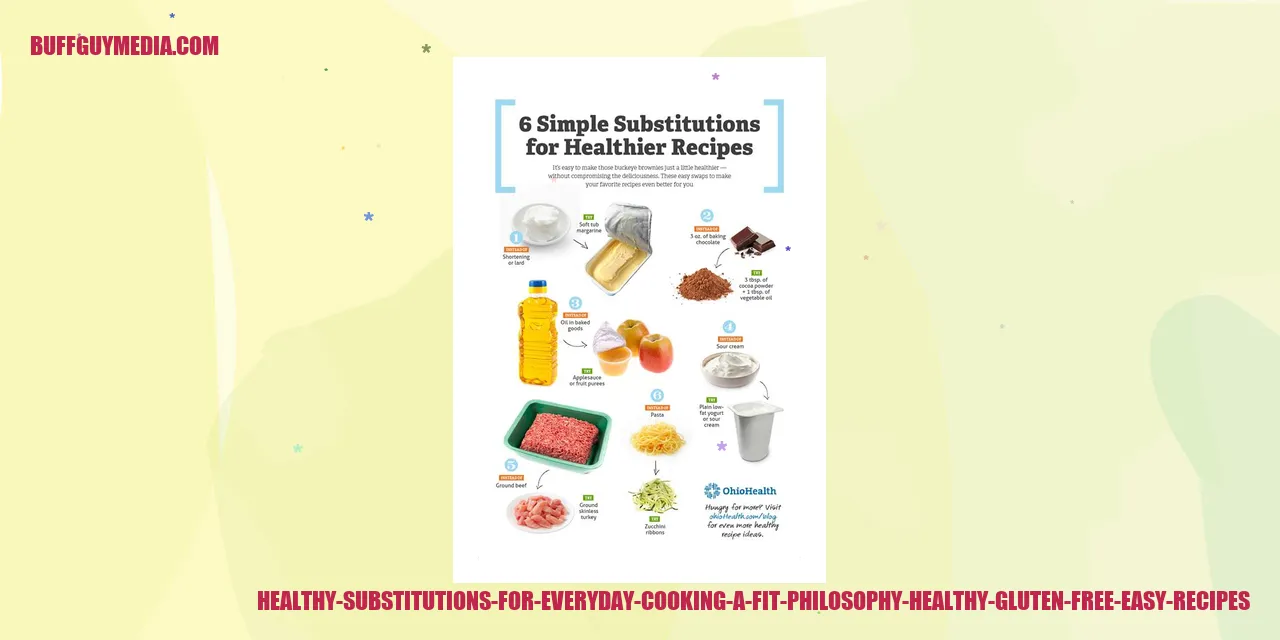
Swapping Butter and Oil
In numerous recipes, butter and oil are commonly used to enhance the flavor and texture of dishes. However, they’re also high in saturated fats and calories. Fortunately, there are healthier alternatives that can be utilized as substitutions. For baking recipes, you can replace butter with applesauce, mashed bananas, or Greek yogurt. These options not only decrease the overall fat content but also impart natural sweetness and moisture to your culinary creations. When cooking savory dishes, consider using olive oil or coconut oil as a healthier alternative to butter. These oils contain heart-healthy fats and can add a delightful taste to your meals.
Healthier Choices instead of Sugar
Sugar is a common ingredient found in many recipes, but excessive consumption has been linked to various health issues. Thankfully, there are several alternatives to sugar that can be used. One option is honey, which enhances natural sweetness and also provides added nutrients. Another choice is maple syrup, which not only offers a distinctive flavor but also contains antioxidants. Stevia and monk fruit extracts are also gaining popularity as sugar substitutes due to their zero-calorie nature and low glycemic index. By utilizing these alternatives, you can reduce your sugar intake without compromising on taste.
Utilizing Whole Grains Instead of White Flour
White flour undergoes heavy processing and lacks the nutritional value present in whole grains. To make your cooking healthier, consider incorporating whole grain flours, such as whole wheat flour, spelt flour, or oat flour. These flours contain higher fiber content, along with essential vitamins and minerals compared to their refined counterparts. When baking, it’s advisable to use a combination of whole grain and white flour for optimal texture. Experimenting with alternative flours like almond flour or coconut flour, which are gluten-free, can also lend a unique taste and texture to your dishes.
Incorporating Vegetables for Added Nutrition
Vegetables are an essential part of a well-balanced diet, yet incorporating them into every meal can be challenging, especially for picky eaters. However, with a little creativity, you can sneak in vegetables to enhance the nutritional value of your dishes. Finely chop vegetables like carrots, zucchini, or bell peppers and add them to sauces, soups, or stews. Another option is to spiralize zucchini or sweet potatoes, providing a healthier alternative to traditional pasta. Including pureed vegetables, such as cauliflower or butternut squash, in macaroni and cheese or mashed potatoes can also add nutrition without sacrificing taste.
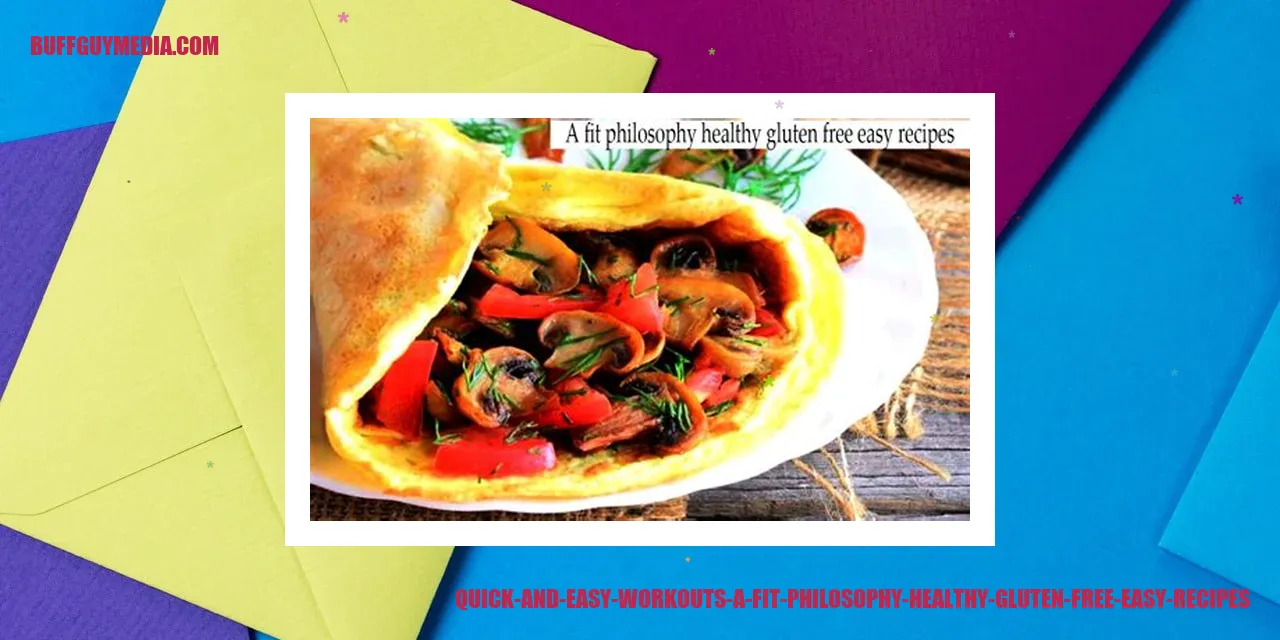
Quick and Convenient Exercise Routines
The Advantages of Short, High-Intensity Workouts
Short and intense workout sessions bring about numerous benefits for individuals aiming to enhance their fitness levels. These routines, usually lasting between 10 to 30 minutes, provide a time-efficient solution for busy people who struggle to find time for exercise in their hectic schedules. In addition to saving time, these intense routines have been found to elevate metabolism and encourage fat burning, even after the exercise is completed. By increasing the heart rate and exerting the muscles, brief and intense workouts aid in improving cardiovascular endurance, building strength, and boosting overall fitness levels.
Effectiveness of Bodyweight Exercises
When it comes to quick and easy workouts, incorporating bodyweight exercises can be an excellent option. Bodyweight exercises rely solely on the individual’s own body as resistance, eliminating the need for equipment or a gym membership. Exercises like push-ups, squats, lunges, and planks engage multiple muscle groups simultaneously, providing a challenging full-body workout. These exercises can be easily modified to accommodate different fitness levels, making them suitable for both beginners and experienced fitness enthusiasts.
Incorporating HIIT into Your Fitness Routine
High-Intensity Interval Training (HIIT) is a popular method for maximizing the effectiveness of quick workouts. HIIT involves alternating between short bursts of high-intensity exercises and brief recovery periods. This type of exercise not only improves cardiovascular fitness but also aids in calorie and fat burning. By incorporating HIIT into your fitness routine, you can achieve better results in a shorter amount of time. It is important, however, to warm up properly and listen to your body to avoid injury.
Tips to Maintain Motivation for Exercising
Maintaining motivation to exercise regularly can be a challenge, but it is crucial for long-term fitness success. Here are some tips to help you stay motivated:
- Set realistic goals: Break your fitness journey into smaller, achievable goals to stay motivated and track your progress.
- Discover enjoyable activities: Engage in activities that you genuinely enjoy to make exercise feel less like a chore.
- Join a workout group or class: Surrounding yourself with like-minded individuals can provide support and motivation.
- Create a consistent schedule: Establishing a regular workout schedule can help make exercise a habit.
- Reward yourself: Celebrate your achievements and milestones to stay motivated and inspired to continue.
In conclusion, incorporating quick and convenient exercise routines into your fitness regimen offers various advantages, including time efficiency, increased fat burning, improved cardiovascular endurance, and overall fitness levels. By utilizing bodyweight exercises and incorporating HIIT, you can maximize the efficacy of your workouts and achieve better results in less time. Remember to stay motivated by setting realistic goals, participating in enjoyable activities, and surrounding yourself with a supportive community. Stay committed to your fitness journey, and you will enjoy the rewards of a healthier and fitter lifestyle.

Delicious and Nourishing Gluten-Free Snack Suggestions
Wholesome Gluten-Free Snacks for Busy Lifestyles
When you find yourself pressed for time and in need of a quick and nutritious snack, there is a wide array of gluten-free options at your disposal. Consider packing a portion of fresh carrot sticks paired with creamy hummus, crispy roasted chickpeas, or a homemade trail mix containing a mix of dried fruits, nuts, and seeds. These delightful snacks not only satisfy your taste buds but also provide essential nutrients to keep you fueled and energized throughout the day.
Homemade Gluten-Free Granola Bars for Health-conscious Consumers
Granola bars are a popular snack choice, but many store-bought varieties contain gluten. By preparing your own gluten-free granola bars, you can tailor the ingredients to suit your preferences and ensure their allergen-free status. Utilize gluten-free oats, a medley of nuts and seeds, and dried fruits to create a mouthwatering and wholesome snack suitable for consumption at any time, whether at home or on the move.
Nutrient-packed Gluten-Free Smoothie Recipes
Smoothies are an ideal way to effortlessly incorporate essential vitamins and minerals into your daily routine, and they can easily be adapted to fit a gluten-free diet. Experiment with an assortment of fruits, vegetables, and various dairy-free milk alternatives to concoct delightful and nourishing gluten-free smoothies. Add a handful of spinach or kale, or even a ripe avocado, to augment the nutritional value, or opt for a refreshing tropical fusion featuring pineapple, mango, and coconut milk.
Irresistible Gluten-Free Desserts That Won’t Break Your Diet
Who says gluten-free snacks can’t be tempting and guilt-free? There is an abundance of delectable dessert options available that are both gluten-free and sensational. Opt for treats prepared with gluten-free flours, such as almond or coconut flour, such as a batch of gluten-free cookies, brownies, or muffins. Experiment with alternative natural sweeteners like maple syrup, honey, or dates to keep your desserts naturally sweet and utterly gratifying.
By incorporating these gluten-free snack suggestions into your dietary routine, you can relish in a diverse range of scrumptious and healthful options. Whether you are in need of a quick on-the-go snack or a delightful dessert, there are plenty of gluten-free alternatives available to cater to your taste preferences and dietary needs. So, channel your creativity in the kitchen and delight in satisfying and nourishing snacks without compromising on taste or health benefits.]
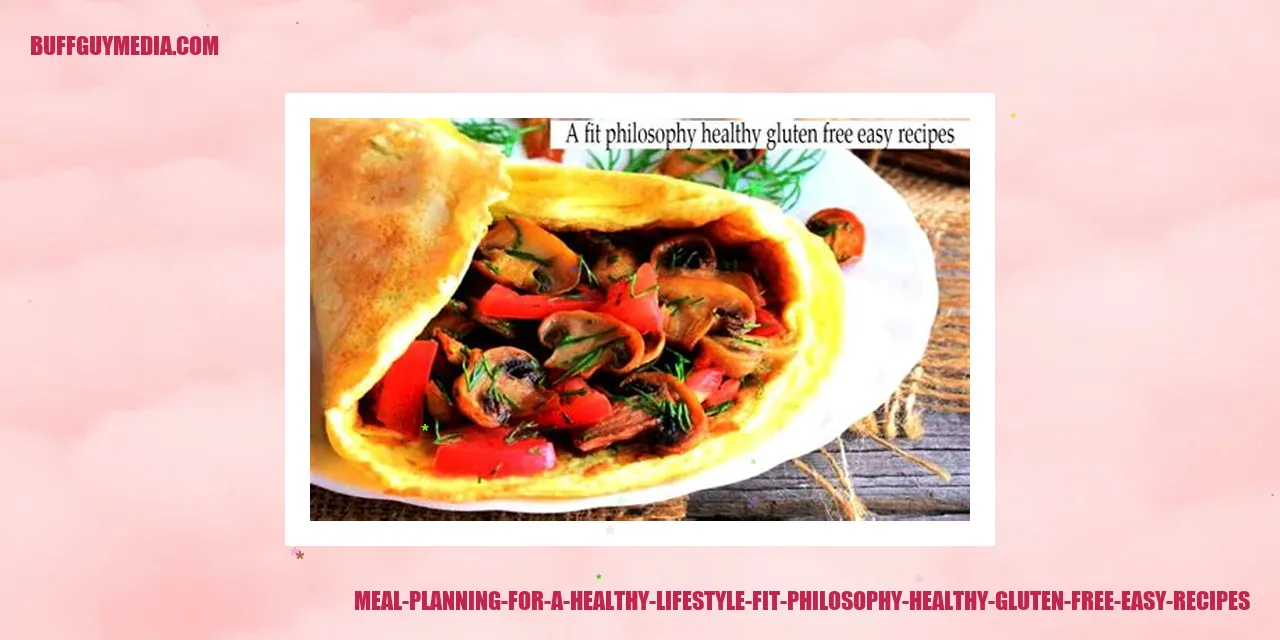
Unlock the Power of Meal Planning for Optimal Health
The Significance of Meal Planning
Incorporating meal planning into your daily routine can have a profound impact on your overall well-being. By meticulously organizing your meals, you ensure access to nutritionally balanced and wholesome choices. Planning your meals in advance empowers you to make conscious decisions that promote healthier dietary habits, enabling you to achieve your fitness aspirations.
Effective Strategies for Successful Meal Planning
When devising a meal plan, it is essential to consider these essential tips:
- Allocate dedicated time each week exclusively for meal planning and grocery shopping.
- Evaluate your pantry and refrigerator to ascertain the ingredients you already possess.
- Structure your meals around your schedule, taking into account any forthcoming engagements or commitments.
- Incorporate a diverse array of fruits, vegetables, whole grains, lean proteins, and healthy fats.
- Pay attention to portion sizes and strive for equilibrium, ensuring your meals deliver all the necessary nutrients.
Crafting Nourishing and Balanced Meals Within Your Plan
To foster equilibrium within your meal plan, strive to include a combination of various food groups. Endeavor to incorporate the following:
- Lean proteins such as poultry, fish, tofu, or legumes.
- Fruits and vegetables to secure vital vitamins, minerals, and fiber.
- Nutrient-rich whole grains like brown rice, quinoa, or whole wheat bread.
- Healthy fats sourced from avocados, nuts, seeds, or olive oil.
- Calcium-rich dairy products or dairy alternatives to fortify your nutrient intake.
Infusing Your Meal Plan with Stimulating Variety
To evade monotony and enhance nutrient diversity, prioritize infusing variety into your meal plan:
- Immerse yourself in new recipes and flavors to keep your taste buds captivated.
- Experiment with various cooking techniques, such as grilling, roasting, or steaming, to elevate taste profiles.
- Incorporate seasonal fruits and vegetables to relish freshness and flavor.
- Delve into international cuisines for a captivating and novel dining experience.
- Consider integrating plant-based meals or Meat alternatives to diversify your culinary encounters.
By heeding these meal planning suggestions and incorporating a refreshing assortment into your plan, you can effortlessly maintain a healthy lifestyle while savoring delightful and nourishing meals. Make meal planning an integral part of your routine, and embark on a transformative journey towards achieving optimal health and wellness.

Frequently Asked Questions About Maintaining a Healthy Lifestyle
1. Understanding the Principles of a Healthy and Fit Lifestyle
Are you curious about the philosophy behind living a fit and healthy lifestyle? Discover the core principles that revolve around a balanced diet, regular physical activity, and nurturing positive habits to promote overall well-being. Learn how conscious choices and a focus on mental and emotional health contribute to your journey towards optimal health and vitality.
2. Integrating Gluten-Free Choices into Your Diet
Interested in incorporating gluten-free options into your dietary routine? Uncover various simple ways to do so. Familiarize yourself with gluten-free grains like quinoa, millet, and buckwheat, which can replace wheat-based products in salads, stir-fries, and porridges. Explore alternatives such as rice cakes, corn tortillas, and gluten-free pasta to diversify your meals. Always prioritize products with certified gluten-free labels.
3. Quick and Nutritious Recipes for Busy Individuals
Struggling to maintain a healthy lifestyle due to a hectic schedule? Discover easy and nutritious recipes curated specifically for busy individuals. From overnight oats and smoothie bowls to lean protein stir-fries and sheet pan dinners, these recipes require minimal preparation and cooking time while offering essential nutrients and flavors. Optimize your time by utilizing meal planning and prepping on weekends.
4. Balancing a Healthy Lifestyle with Long Work Hours
Does your demanding work schedule make it difficult to lead a healthy lifestyle? Learn effective time management strategies and prioritization techniques to maintain your well-being. Plan your meals ahead and bring wholesome snacks to avoid relying on unhealthy options during office hours. Incorporate short bursts of exercise throughout the day, manage stress levels, and prioritize self-care activities like sleep, relaxation, and leisure.
5. Why Regular Exercise is Beneficial
Discover the myriad benefits of regular exercise for both physical and mental well-being. Maintain a healthy weight, strengthen your muscles and bones, improve cardiovascular health, and enhance overall fitness levels. Experience mood elevation through the release of feel-good endorphins while reducing stress. Exercise also aids in quality sleep, increased energy levels, and prevention of chronic conditions such as obesity, diabetes, and heart disease.
6. Cultivating Healthy Eating Patterns
Gain insights into developing healthy eating habits that nurture your body with nourishing food. Incorporate a variety of fruits, vegetables, whole grains, and lean proteins into your meals. Avoid processed foods containing high amounts of added sugars, unhealthy fats, and sodium. Practice portion control, attend to your body’s hunger and fullness cues, and embrace mindful eating. Stay hydrated, limit alcohol consumption, and refrain from excessive snacking.
7. Prioritizing Self-Care Amidst a Busy Lifestyle
Discover essential strategies for prioritizing self-care in today’s fast-paced world. Establish boundaries and learn to decline commitments when necessary. Allocate time for activities that bring joy and relaxation, such as reading, meditating, and spending time in nature. Ensure restful sleep by adhering to a consistent sleep schedule and implementing a soothing bedtime routine. Seek support from loved ones or professionals when needed, as self-care also involves asking for help.
